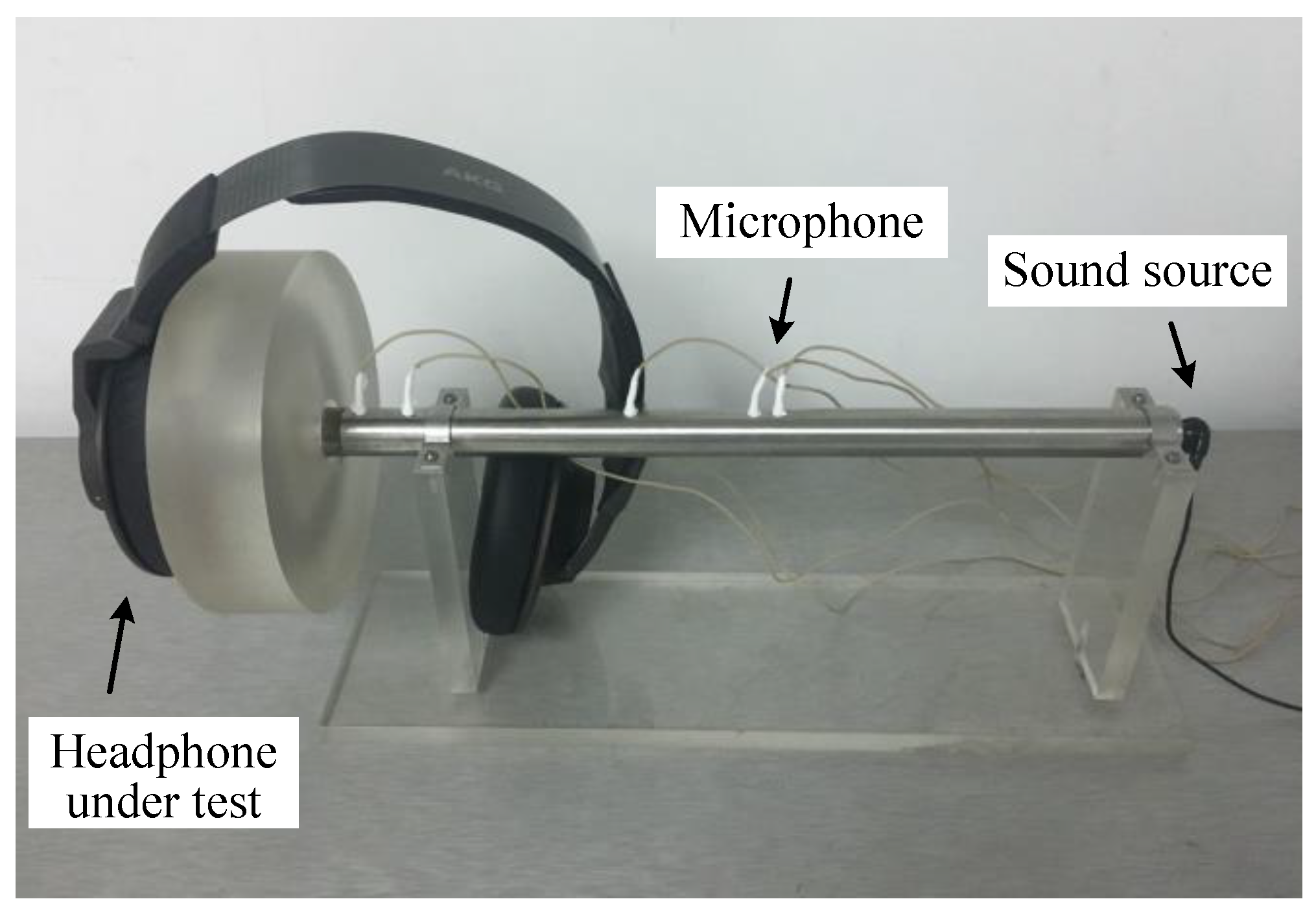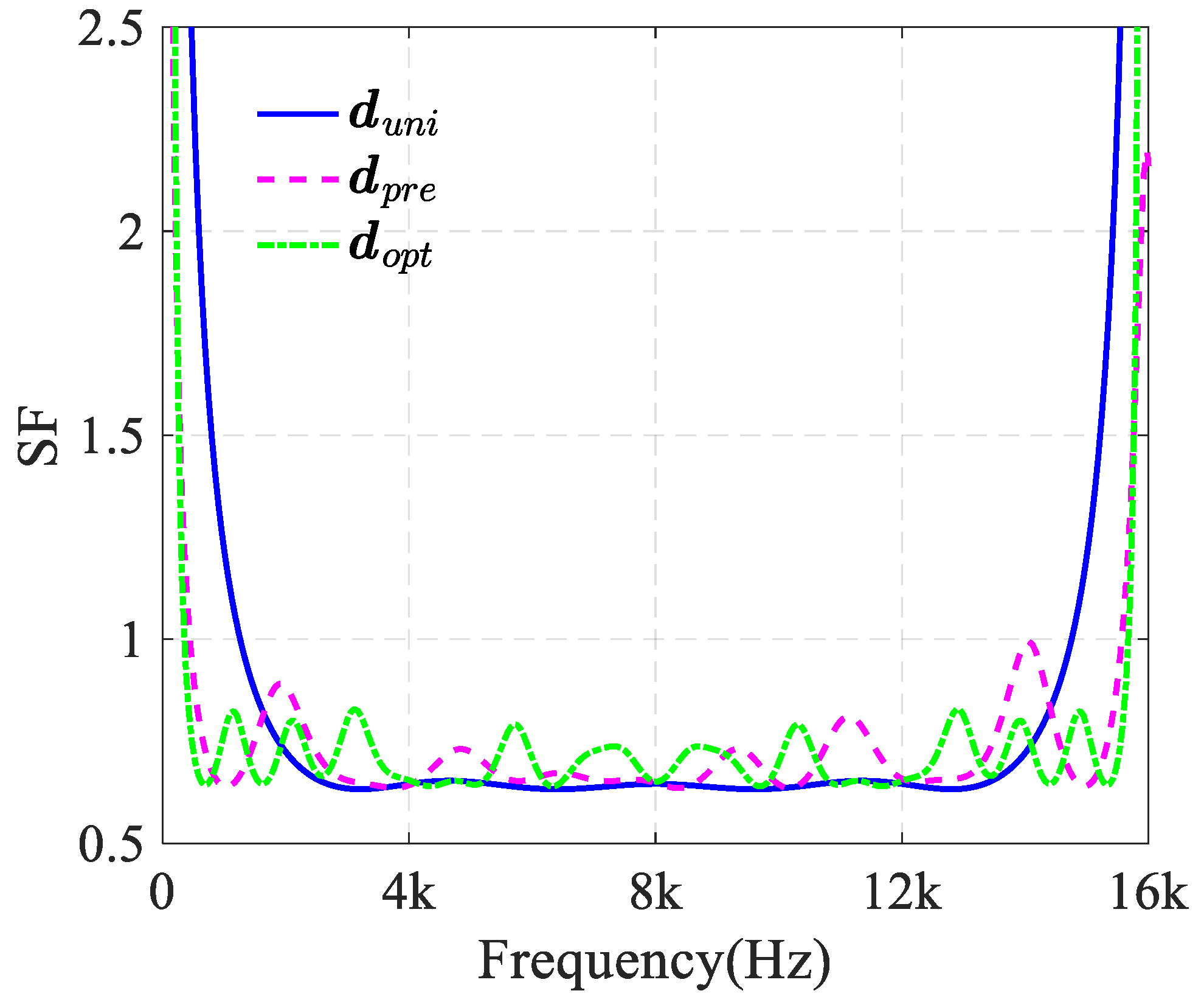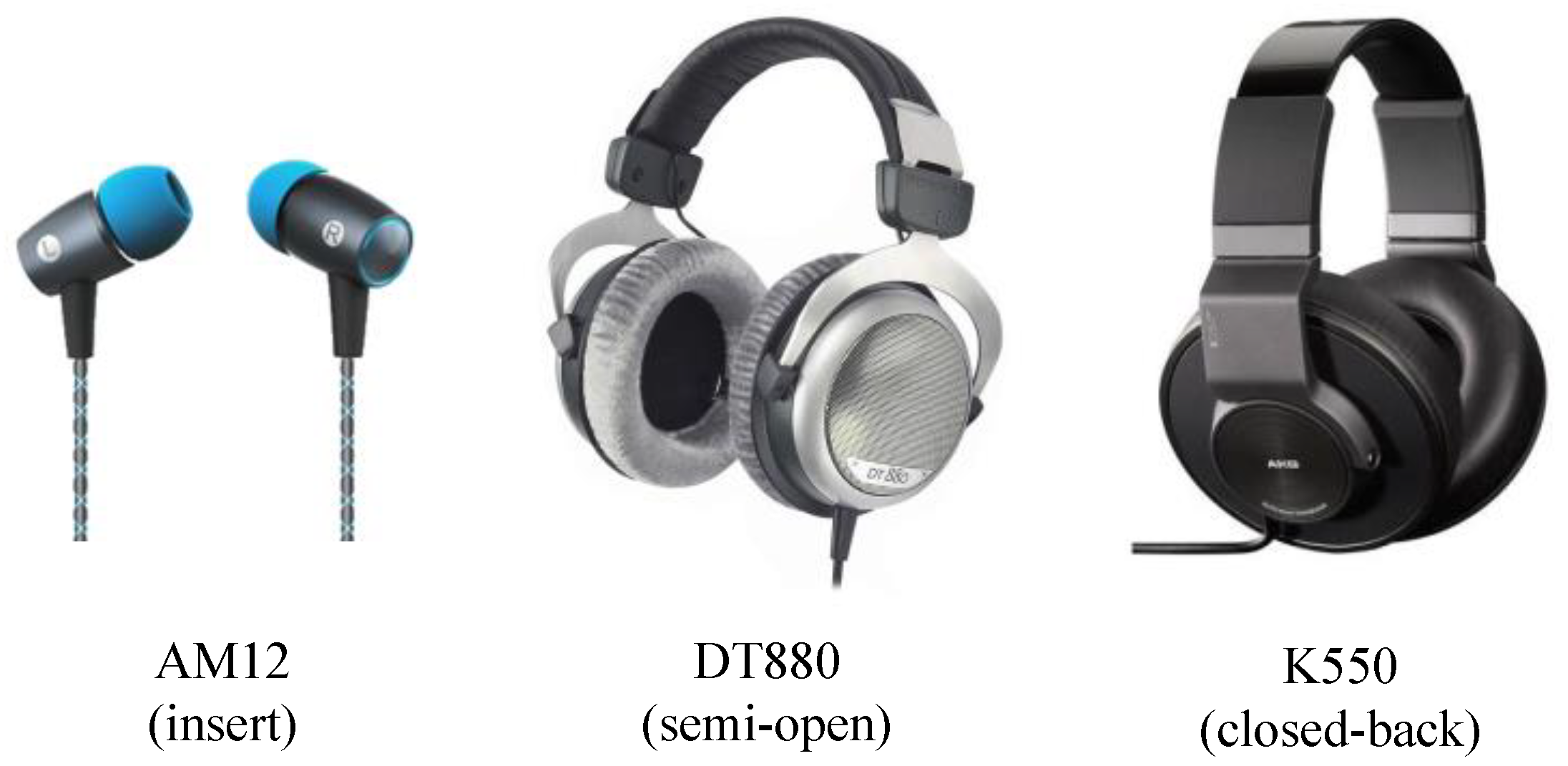Headphone-To-Ear Transfer Function Estimation Using Measured Acoustic Parameters
Abstract
:1. Introduction
2. The Microphone Array Method for Measuring Acoustic Reflectance
2.1. Theory
2.2. Error Analysis
3. Experiments
3.1. Measurements of Headphone Acoustic Reflectance
3.2. Measurements of Headphone Equivalent Sound Sources
4. Estimation of HpTFs
5. Conclusions
Author Contributions
Acknowledgments
Conflicts of Interest
References
- Møller, H. Fundamentals of binaural technology. Appl. Acoust. 1992, 36, 171–218. [Google Scholar] [CrossRef]
- IEC 60318-4. Electroacoustics—Simulators of Human Head and Ear—Part 4: Occluded-Ear Simulator for the Measurement of Earphones Coupled to the Ear by Means of Ear Inserts; International Electrotechnical Commission: Geneva, Switzerland, 2010. [Google Scholar]
- Boren, B.B.; Geronazzo, M.; Majdak, P.; Choueiri, E. PHOnA: A public dataset of measured headphone transfer functions. In Audio Engineering Society Convention 137; Audio Engineering Society: New York, NY, USA, 2014. [Google Scholar]
- Møller, H.; Hammershøl, D.; Jensen, C.B.; Sørensen, M.F. Transfer characteristics of headphones measured on human ears. J. Audio Eng. Soc. 1995, 43, 203–217. [Google Scholar]
- Begault, D.R.; Trejo, L.J. 3-D Sound for Virtual Reality and Multimedia Cambridge; Academic Press Professional: Cambridge, MA, USA, 2000. [Google Scholar]
- Møller, H.; Sørensen, M.F.; Hammershøl, D. Binaural technique: Do we need individual recording? J. Audio Eng. Soc. 1996, 44, 451–469. [Google Scholar]
- Lindau, A.; Brinkmann, F. Perceptual evaluation of headphone compensation in binaural synthesis based on non-individual recordings. J. Audio Eng. Soc. 2012, 60, 54–62. [Google Scholar]
- Schärer, Z.; Lindau, A. Evaluation of equalization methods for binaural signals. In Audio Engineering Society Convention 126; Audio Engineering Society: New York, NY, USA, 2009. [Google Scholar]
- Xie, B. Head-Related Transfer Function and Virtual Auditory Display; J. Ross Pub.: Plantation, FL, USA, 2013. [Google Scholar]
- Deng, H.Q.; Yang, J. Modeling and estimating acoustic transfer functions of external ears with or without headphones. J. Acoust. Soc. Am. 2015, 138, 694–707. [Google Scholar] [CrossRef] [PubMed]
- Shaw, E.A.G. The external ear: New knowledge. Scand. Audiol. Suppl. 1975, 5, 24–50. [Google Scholar]
- Hudde, H.; Engel, A. Measuring and modeling basic properties of the human ear and ear canal. Part III: Eardrum impedances, transfer functions and model calculations. Acust. Acta Acust. 1998, 84, 1091–1108. [Google Scholar]
- Stinson, M.R.; Lawton, B.W. Specification of the geometry of the human ear canal for the prediction of sound-pressure level distribution. J. Acoust. Soc. Am. 1989, 85, 2492–2503. [Google Scholar] [CrossRef] [PubMed]
- Deng, H.Q.; Yang, J. Estimating ear canal geometry and eardrum reflection coefficient from ear canal input impedance. In Proceedings of the 2016 IEEE international conference on Acoustics, Speech and Signal Processing, Shanghai, China, 20–25 March 2016; IEEE: Piscataway, NJ, USA; pp. 251–255. [Google Scholar]
- Liu, J.L.; Deng, H.Q.; Yang, J. A five-microphone method to measure the reflection coefficients of headsets. In Proceedings of the INTER-Noise and NOISE-CON Congress and Conference Proceedings, Hamburg, Germany, 21–24 August 2016. [Google Scholar]
- Hiipakka, M.; Karjalainen, M.; Pulkki, V. Modeling of external ear acoustics for insert headphone usage. J. Audio Eng. Soc. 2010, 58, 269–281. [Google Scholar]
- Keefe, D.H.; Ling, R.; Bulen, J.C. Method to measure acoustic impedance and reflection coefficient. J. Acoust. Soc. Am. 1992, 91, 470–485. [Google Scholar] [CrossRef] [PubMed]
- Cox, T.; D’Antonio, P. Acoustic Absorbers and Diffusers: Theory, Design and Application; CRC Press: Boca Raton, FL, USA, 2016. [Google Scholar]
- Mechel, F.P. Formulas of Acoustics; Springer: Berlin/Heidelberg, Germany, 2008. [Google Scholar]
- International Organization for Standardization (ISO). Acoustics—Determination of Sound Absorption Coefficient and Impedance in Impedance Tubes—Part 2: Transfer-Function Method; ISO 10534-2; International Organization for Standardization: Geneva, Switzerland, 1998. [Google Scholar]
- Jang, S.H.; Ih, J.G. On the multiple microphone method of measuring in-duct acoustic properties in the presence of mean flow. J. Acoust. Soc. Am. 1998, 103, 1520–1526. [Google Scholar] [CrossRef]
- Boden, H.; Abom, M. Influence of errors on the two-microphone method for measuring acoustic properties in ducts. J. Acoust. Soc. Am. 1986, 79, 541–549. [Google Scholar] [CrossRef]
- Voss, S.E.; Allen, J.B. Measurement of acoustic impedance and reflectance in the human ear canal. J. Acoust. Soc. Am. 1994, 95, 372–384. [Google Scholar] [CrossRef] [PubMed]






© 2018 by the authors. Licensee MDPI, Basel, Switzerland. This article is an open access article distributed under the terms and conditions of the Creative Commons Attribution (CC BY) license (http://creativecommons.org/licenses/by/4.0/).
Share and Cite
Liu, J.; Deng, H.; Ji, P.; Yang, J. Headphone-To-Ear Transfer Function Estimation Using Measured Acoustic Parameters. Appl. Sci. 2018, 8, 918. https://doi.org/10.3390/app8060918
Liu J, Deng H, Ji P, Yang J. Headphone-To-Ear Transfer Function Estimation Using Measured Acoustic Parameters. Applied Sciences. 2018; 8(6):918. https://doi.org/10.3390/app8060918
Chicago/Turabian StyleLiu, Jinlin, Huiqun Deng, Peifeng Ji, and Jun Yang. 2018. "Headphone-To-Ear Transfer Function Estimation Using Measured Acoustic Parameters" Applied Sciences 8, no. 6: 918. https://doi.org/10.3390/app8060918



